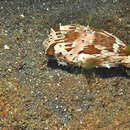Diagnostic Description
provided by Fishbase
Pelagic juveniles with spots, particularly prominent on belly; adults with dark blotches across back and spots between the blotches; fins without spots (Ref. 4423). 14 to 16 spines in an approximate row between snout and origin of dorsal fin; with a large brown bar above and below each eye; a broad transverse brown bar on occipital region of head (Ref. 13442).
- Recorder
- Cristina V. Garilao
Diseases and Parasites
provided by Fishbase
Lymphocystis Disease. Viral diseases
Morphology
provided by Fishbase
Dorsal spines (total): 0; Dorsal soft rays (total): 13 - 15; Analspines: 0; Analsoft rays: 13 - 15
- Recorder
- Cristina V. Garilao
Trophic Strategy
provided by Fishbase
Inhabits lagoon and seaward reefs (Ref. 37816, 58534) to open shallow, soft bottoms. Occurs on open muddy substrates as well as on rich soft-bottom and coral reefs. Also in areas with rocky substrata. Young and sub-adults may form small groups (Ref. 48637). Juveniles pelagic to about 6-9 cm. Solitary. Feeds on mollusks, sea urchins, hermit crabs, shellfish and crabs at night (Ref. 9680, 54301). Mobile-invertebrate feeder (Ref. 57615, 57616). Sessile invertebrate feeder (Ref. 126840). A relatively poor swimmer (Ref. 9710). A relatively poor swimmer (Ref. 9710).
Biology
provided by Fishbase
Inhabit shallow reefs to open, soft bottoms. Also in areas with rocky substrata. Sometimes form groups (Ref. 9710, 48637). Occur on open muddy substrates as well as on rich soft-bottom and coral reefs. Juveniles often with floating Sargassum rafts. Young and sub-adults may form small groups (Ref. 48637). Benthopelagic (Ref. 58302). Juveniles pelagic to about 6-9 cm. Solitary. Feed on mollusks, sea urchins, hermit crabs, and crabs at night (Ref. 9680). Relatively poor swimmers (Ref. 9710). Used in Chinese medicine (Ref. 12166). Captured at the surface using a hand net (Ref. 26165).
- Recorder
- Crispina B. Binohlan
Importance
provided by Fishbase
fisheries: minor commercial; aquarium: commercial; price category: unknown; price reliability:
- Recorder
- Crispina B. Binohlan

